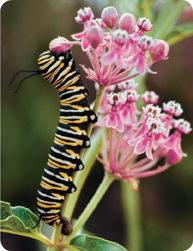Flowers and Pollinators Coevolution of flowers and pollinators is common and can lead to unusual results. For example, Darwin discovered an orchid whose flowers had a long structure called a spur. Way down at the bottom of that 40-centimeter-long spur is a supply of nectar, which could serve as food for any insect able to reach it. But what insect could reach it? Darwin predicted that some pollinating insect must have some kind of feeding structure that would allow it to reach the nectar. Darwin never saw that insect. But about 40 years later, researchers discovered a moth with a 40-centimeter-long feeding tube that matched Darwin's prediction!
Plants and Herbivorous Insects Plants and herbivorous insects also demonstrate close, albeit less “friendly,” coevolutionary relationships. Insects have been feeding on flowering plants since both groups emerged. Over time, many plants evolved bad-tasting or poisonous compounds that discourage insects from eating them. Some of the most powerful natural poisons are compounds developed by plants in response to insect attacks. But once plants began to produce poisons, natural selection on herbivorous insects favored any variants that could alter, inactivate, or eliminate those poisons. Time and again, a group of insects, like the caterpillar in Figure 19–13, evolved a way to deal with the particular poisons produced by a certain group of plants.

FIGURE 19–13 Plants and Herbivorous Insects Milkweed plants produce toxic chemicals. But monarch caterpillars not only can tolerate this toxin, they also can store it in their body tissues to use as a defense against their predators.
19.2 Assessment

-
Review How does variation within a clade affect the clade's chance of surviving environmental change?
Compare and Contrast How is mass extinction different from background extinction?
-
Review Explain how punctuated equilibrium is different from gradualism.
Relate Cause and Effect Why would evolution speed up when a small group of organisms migrates to a new environment?
-
Review What is adaptive radiation?
Relate Cause and Effect When might adaptive radiation result in convergent evolution?
-
Review What is coevolution?
Apply Concepts Describe an example of coevolution.
Apply the Big idea
What role does the environment play in convergent evolution?

Table of Contents
- Formulas and Equations
- Applying Formulas and Equations
- Mean, Median, and Mode
- Estimation
- Using Measurements in Calculations
- Effects of Measurement Errors
- Accuracy
- Precision
- Comparing Accuracy and Precision
- Significant Figures
- Calculating With Significant Figures
- Scientific Notation
- Calculating With Scientific Notation
- Dimensional Analysis
- Applying Dimensional Analysis




